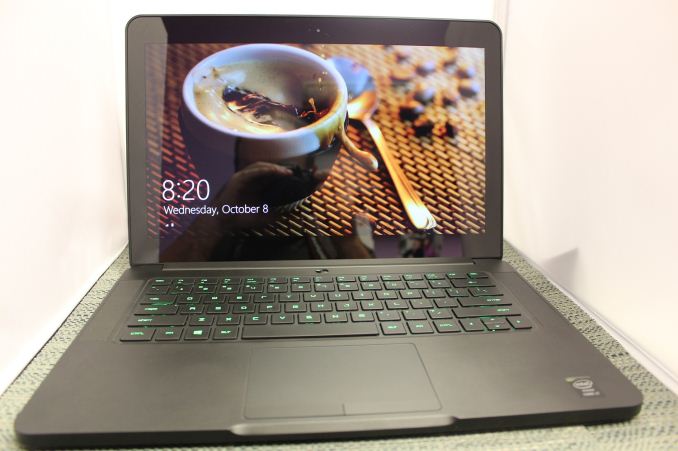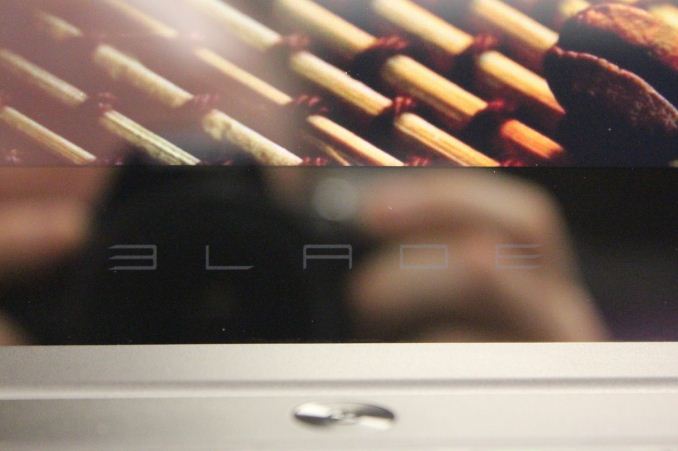The 2014 Razer Blade Review
by Brett Howse on October 10, 2014 9:00 AM EST- Posted in
- Notebooks
- Gaming
- Laptops
- Razer Blade
Final Words
The 2013 Razer Blade was a fantastic notebook computer with an abysmal display. For 2014, Razer has put one of the best displays we have ever tested in a laptop into the Blade, and it truly completes the experience. Razer’s slogan is “For Gamers, by Gamers” and we have to first evaluate the Razer Blade as a gaming laptop. Here it succeeds almost completely.
With a quad-core Intel Core i7 and an NVIDIA GeForce GTX 870M, there is a lot of processing power. The 14 inch Blade runs with larger gaming systems in our benchmarks, and it does all of this without throttling under load. It does get hot, but for the most part it is not hot where you will be touching it.
The high PPI display also looks fantastic when gaming at the native resolution, but the 3200x1800 resolution certainly taxes the available GPU power, and in order to push almost 6 million pixels some of the effects in games will need to be turned down. Luckily this is generally a very easy process for a lot of games due to the GeForce Experience software. If the game you want to play is not in the NVIDIA database though, expect some trial and error to find a frame rate and graphical quality that works for you. Perhaps a 2015 refresh of the system with the GTX 970M will be the solution to this.
If you are looking for a powerful, portable, well-built gaming laptop, you would be hard pressed to find something more pleasing for the task. There are faster systems out there, but they are generally larger and heavier, so you would lose the portability of a 14 inch system. In the past, gaming laptops were meant to move from one table to another, but the Razer Blade has shown that this does not need to be the case.
Portability is one of the biggest aspects of the 2014 Razer Blade. The CNC aluminum body is thin and light. Yet inside is a 70 Wh battery that allows the Blade to be used unplugged from the mains for a reasonable amount of time. Battery life is not record setting, but considering the amount of performance inside and the high PPI display, it is generally adequate.
When you have a system of this quality and price, you have to assume no one is going to buy it just as a system to game on. As a general purpose PC, the Razer Blade is also very good. Performance is very quick due to the Samsung SSD, and the display once again is the star of the show with fantastic color reproduction and great viewing angles. The Blade looks and feels a lot like a 15 inch MacBook Pro, and likely by design.
The two machines both have high resolution displays, strong aluminum bodies, and the size and weight are so close the comparisons are unavoidable. But as a general use laptop, the rMBP does edge the Razer in some key areas. It has a faster CPU, it comes with a default of 512GB PCI-e based SSD, and most importantly it comes with 16GB of memory. The GPU is a much less potent GT 750M though, but for applications that is generally not such a big deal. I would have liked to see Razer bump the memory to 16GB, which would allow the Razer Blade to be used for many more tasks, especially running Virtual Machines.
While I would like to see the 16GB of memory, that does not detract from what is already there. Overall the Razer Blade is a fantastic laptop, with excellent build quality, great acoustics, a powerful CPU and GPU, and now, finally, an amazing display. The 2013 model was well reviewed despite the horrible display, due to the thin and light design. You can see the effort put into the 2014 model to ensure that the mistakes of the last model are rectified, and they certainly are.
The price has crept up a bit over last year though, with the base cost now at $2200 USD. But that is only with 128GB of storage, which really isn't sufficient , so most users will have to jump up to the $2400 USD 256GB model. That's expensive to be sure, but for the money you get one of the best notebooks with one of the best displays money can buy, even several months after launch.












69 Comments
View All Comments
Notmyusualid - Saturday, October 11, 2014 - link
I am a VERY frequent traveller, and I've seen a few Alienware backpacks as I go through airports.I carry my M18x R2 with me everywhere I go, and yes it is heavy, but they are made for adults, right?
Every customer I meet is fascinated to meet my Alienware machine, and it is a great talking point when meeting new customers.
And what is with your 2hrs of battery life? Are you not aware we have integrated graphics, on a 96whr 12-cell battery? Imagine how long that lasts...
If you think there is an image problem associated with these machines, I'd quite enjoy you expressing that opinion to my face... whilst demonstraiting what machine you carry around.
Connoisseur - Saturday, October 11, 2014 - link
I thought it's fairly obvious I carry around a Razer Blade 2014. Listen, I'm not here to get into a laptop beat down contest and I'm a little confused as to why you want me to say anything to your face. I'm not insulting your family, merely your commentary on why people shouldn't be buying these machines. The markets for the two types of machine are very different. Alienware is marketed to and has the reputation of being a college gamers machine; it's always been this way. Their design language and form factor scream "Look at me! I'm sparkly and huge and look like a sci-fi tank!" I used to build systems like that back in college which had LED's with cases that had crazy angles. As I aged, my tastes changed and I preferred something that looks more subtle and slimmer. My wife would make endless fun of me if I carried that monster around.If you're comfortable toting around 15lbs total of computer parts (laptop + power brick) and using an 18" screen on an airplane tray or on your lap, more power to you. I prefer something I can tuck under my arm. Not to mention that I frequently have to also carry around my work laptop and the use case for a slim, lightweight gaming system makes a lot of sense.
DPOverLord - Friday, October 10, 2014 - link
Doesn't seem that great. Did they need such a high res screen? For $2k that GPU may not run it well. Make it a 970/980 with the new refresh.Then upgrade the CPU... Also, weight should not go up.
DPOverLord - Saturday, October 11, 2014 - link
Realized this is not new. Stop reviewing 'old hardware' or at least put a spoiler that you're reviewing something that came out months ago. Bit confusing since I was here thinking "wtf is razer doing"zepi - Friday, October 10, 2014 - link
It sure looks nicer than MSI GS60, but is that alone worth the extra cost? Especially when new version of the MSI is just about to come out with GTX 970M...whyso - Friday, October 10, 2014 - link
Love the review but I feel that these notebook reviews need for the games and CPU benchmark sections the CPU and GPU name beside the name of the notebook for quick and easy comparison.Awful - Friday, October 10, 2014 - link
What use case are they actually targeting with that screen resolution? It sure isn't gaming...Morawka - Friday, October 10, 2014 - link
i wonder how a gaming laptop would be if it used Broadwell Core M for very low power dual core performance at 5-10 watt, and devote the rest of the TDP to GPU. This would prevent throttling whene on battery so long as total system draw is under 100W. 100W is about the peak of what laptop batteries can put out.kallogan - Saturday, October 11, 2014 - link
i'd like to see that too a core m 5yxx would run easy at constant full dual core turbo in a notebook chassis even with a very weak cooling, would give enough cpu power and would let the gpu a lot of tdp room !!!! Under 100W with a premium class gpu would be great.But sadly i don't think core m 5yxx are intended to be paired with discrete gpus, only for convertibles tablets and such but we'll see. Later Broadwell cpus it will be.
But as a gamer concerned mostly by cooling and noise and not caring for a premium cpu as long as there is no major cpu limiting i'm definitely for devoting the power to gpus !!!
limitedaccess - Saturday, October 11, 2014 - link
ULV and lower power Intel mobile CPUs (including the new Core-M series) are limited to PCie 2.0 x4 while M/Q CPUs have the a full PCie 3.0 x16 available to them.The only GTX x60m+ class laptop I'm aware of that pairs with a non M/Q CPU was the announced (but not yet released) Alienware 13 with a Haswell-U + GTX 860m. However there was, I believe, some uncertainty regarding whether that will be the actual CPU configuration.